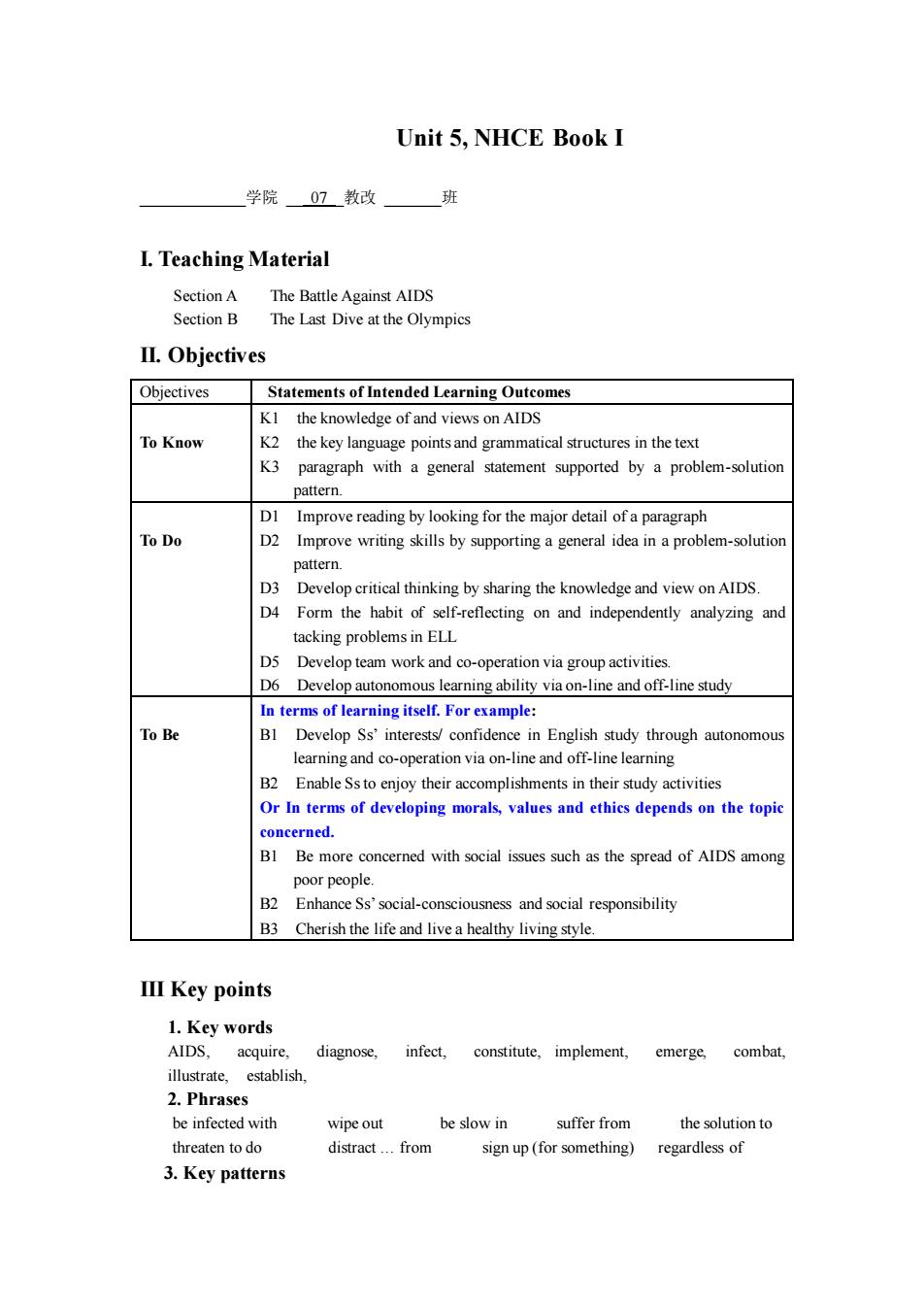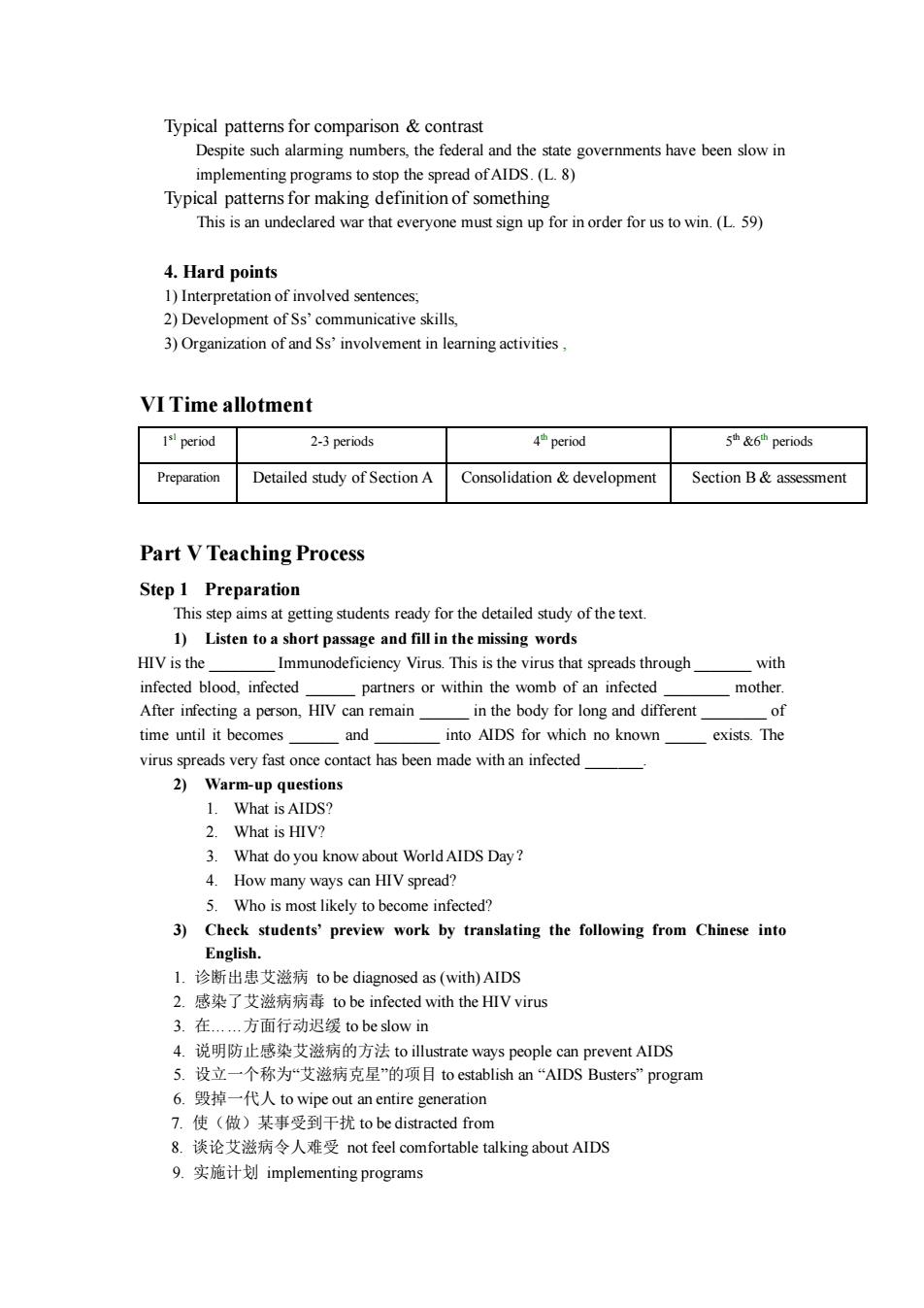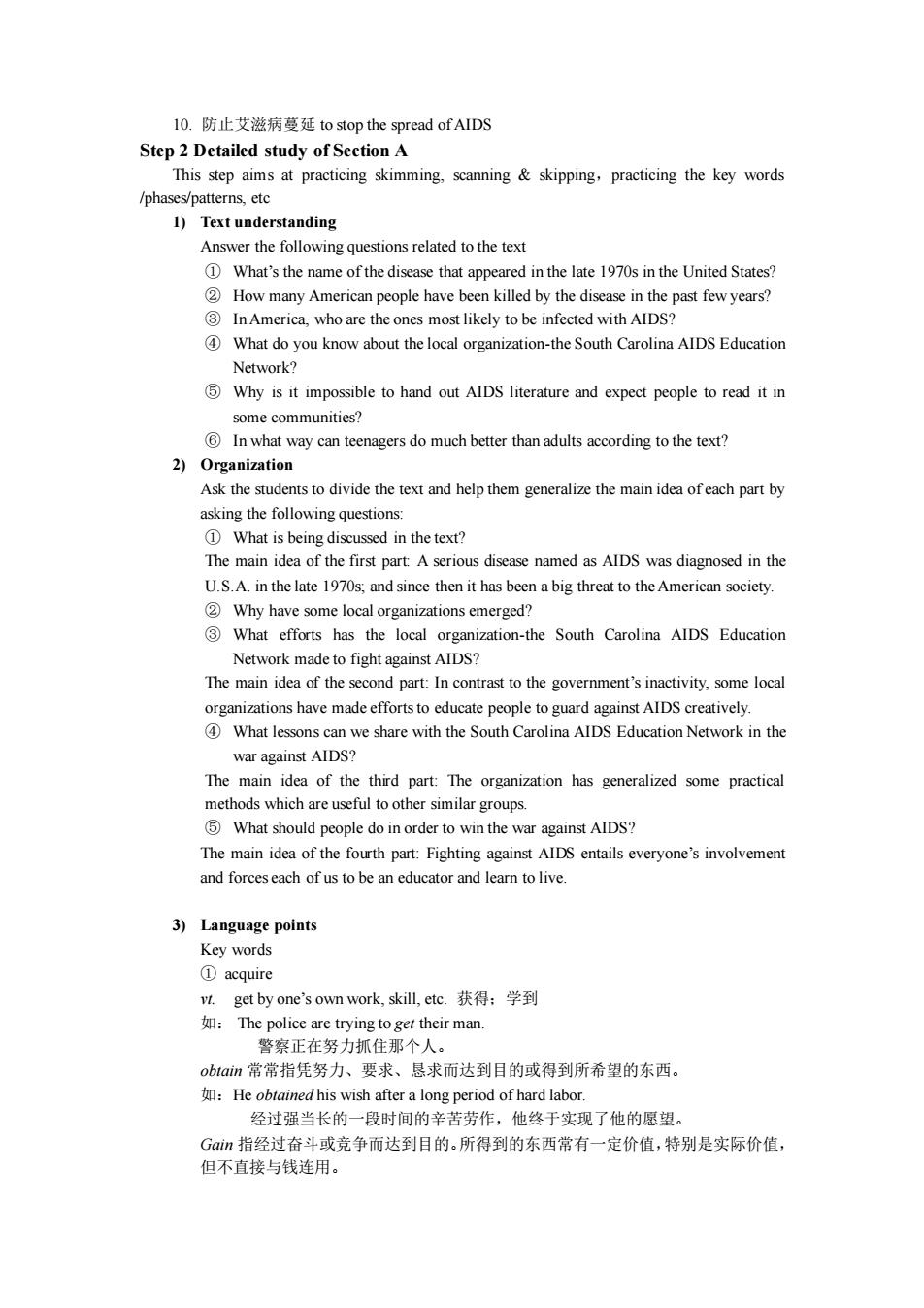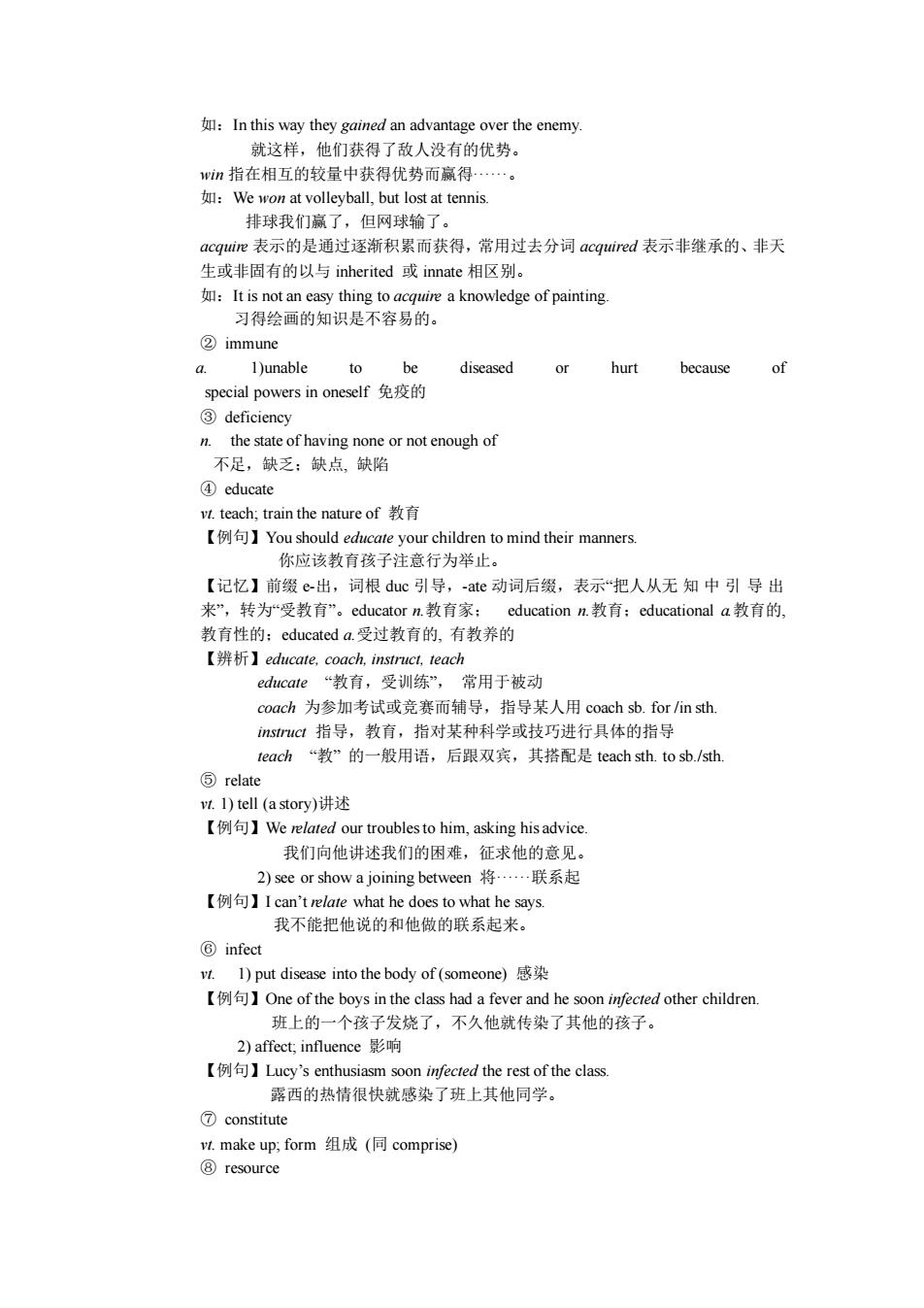
Unit 5,NHCE Book I 学院_0教改 班 I Teaching Material The Battle Against AIDS Section B The Last Dive at the Olympics II.Objectives Objectives Statements of Intended Learning Outcomes KI the knowledge of and views on AIDS To Know K2 the key language points and grammatical structures in the text K3 paragraph with a general statement supported by a problem-solution pattern D1 Improve reading by looking for the major detail of a paragraph ToDo D2 Improve writing skills by supporting a general idea in a problem-solutic pattern D3 Develop critical thinking by sharing the knowledge and view on AlDS. D4 Form the habit of self-reflecting on and independently analyzing and tacking problems in ELL Develop team work and co-opera on vi group activities D6 Develop autonomous learning ability via on-line and off-line study In terms of learning itself.For example: To Be BI Develop Ss'interests/confidence in English study through autonomou learning and co-operation via on-line and off-line learning B their accomplishments in their study activities Or In terms of developing morals,values and ethics depends on the topic concerned. BI Be more concerned with social issues such as the spread of AIDS among poor people. B2 Enhance Sssocial-consciousness and social responsibility B3 Cherish the life and livea healthy living style. III Key points 1.Key words AIDS, acquire diagnose,infect,constitute,implement,emerge,combat illustrate,establish. 2.Phrases be infected with wine out be slow in suffer from the solution to threaten todo distract.from sign up(for something)regardless of 3.Key patterns
Unit 5, NHCE Book I _学院 _07_教改 _班 I. Teaching Material Section A The Battle Against AIDS Section B The Last Dive at the Olympics II. Objectives Objectives Statements of Intended Learning Outcomes To Know K1 the knowledge of and views on AIDS K2 the key language points and grammatical structures in the text K3 paragraph with a general statement supported by a problem-solution pattern. To Do D1 Improve reading by looking for the major detail of a paragraph D2 Improve writing skills by supporting a general idea in a problem-solution pattern. D3 Develop critical thinking by sharing the knowledge and view on AIDS. D4 Form the habit of self-reflecting on and independently analyzing and tacking problems in ELL D5 Develop team work and co-operation via group activities. D6 Develop autonomous learning ability via on-line and off-line study To Be In terms of learning itself. For example: B1 Develop Ss’ interests/ confidence in English study through autonomous learning and co-operation via on-line and off-line learning B2 Enable Ss to enjoy their accomplishments in their study activities Or In terms of developing morals, values and ethics depends on the topic concerned. B1 Be more concerned with social issues such as the spread of AIDS among poor people. B2 Enhance Ss’social-consciousness and social responsibility B3 Cherish the life and live a healthy living style. III Key points 1. Key words AIDS, acquire, diagnose, infect, constitute, implement, emerge, combat, illustrate, establish, 2. Phrases be infected with wipe out be slow in suffer from the solution to threaten to do distract . from sign up (for something) regardless of 3. Key patterns

Despite such aarming numbers,the federal and the state governments have been implementing programs to stop the spread of AIDS.(L8) Typical patterns for making definition of something This is an undeclared war that everyone must sign up for in order for us to win.(L.59) 4.Hard points 1)Interpretation of involved sentences. 2)Development of Ss'communicative skills, 3)Organization of and Ss'involvement in learning activities VI Time allotment 1"period 2-3 periods 4 period periods Preparation Detailed study of Section A Consolidation development Section B&assessment Part V Teaching Process Step 1 Preparation 1)Listen toa short passage and fill in the missing words HIV is the】 Immunodeficiency Virus.This is the virus that spreads through 、with infected blood,infected partners or within the womb of an infected mother. After infecting a person,HIV can remain in the body for long and different of time until it becomes and into AIDs for which no known exists.The virus spreads very fastonce has been made with n infected 2)Warm-up questions 1.What is AIDS? 2.What is HIV? 3.What do you know about WorldAIDS Day? 4.How many ways can HIV spread? Who is most likely to become infected 3)Check students'preview work by translating the following from Chinese into English. L.诊断出患艾滋病to be diagnosed as(with)ADS 2感染了艾藏病病毒to be infected with the hiy virus 3.在 方面行动迟缓to beslow in 4.说明防止感染艾滋病的方法toilustrate ways people can prevent AIDS 5.设立一个称为艾滋病克星”的项目to establish an“AIDS Busters'”program 6.毁掉一代人to wipe out an entire generation 7.使(做)某事受到干扰to be distracted from 8.谈论艾滋病令人难受not feel comfortable talking about AIDS 9.实施计划implementing programs
Typical patterns for comparison & contrast Despite such alarming numbers, the federal and the state governments have been slow in implementing programs to stop the spread of AIDS. (L. 8) Typical patterns for making definition of something This is an undeclared war that everyone must sign up for in order for us to win. (L. 59) 4. Hard points 1) Interpretation of involved sentences; 2) Development of Ss’ communicative skills, 3) Organization of and Ss’ involvement in learning activities , VI Time allotment 1 s1 period 2-3 periods 4 th period 5 th &6th periods Preparation Detailed study of Section A Consolidation & development Section B & assessment Part V Teaching Process Step 1 Preparation This step aims at getting students ready for the detailed study of the text. 1) Listen to a short passage and fill in the missing words HIV is the _ Immunodeficiency Virus. This is the virus that spreads through _ with infected blood, infected _ partners or within the womb of an infected _ mother. After infecting a person, HIV can remain _ in the body for long and different _ of time until it becomes _ and _ into AIDS for which no known _ exists. The virus spreads very fast once contact has been made with an infected _. 2) Warm-up questions 1. What is AIDS? 2. What is HIV? 3. What do you know about World AIDS Day? 4. How many ways can HIV spread? 5. Who is most likely to become infected? 3) Check students’ preview work by translating the following from Chinese into English. 1. 诊断出患艾滋病 to be diagnosed as (with) AIDS 2. 感染了艾滋病病毒 to be infected with the HIV virus 3. 在.方面行动迟缓 to be slow in 4. 说明防止感染艾滋病的方法 to illustrate ways people can prevent AIDS 5. 设立一个称为“艾滋病克星”的项目 to establish an “AIDS Busters” program 6. 毁掉一代人 to wipe out an entire generation 7. 使(做)某事受到干扰 to be distracted from 8. 谈论艾滋病令人难受 not feel comfortable talking about AIDS 9. 实施计划 implementing programs

l0.防止艾滋病蔓延to stop the spread ofAIDS Step 2 Detailed study of Section A This step aims at practicing skimming.scanningskipping,practicing the key words /phases/patterns,eto 1)Text understanding Answer the following questions related to the text What's the name ofi thate people have be merica.who are the ones most likely to be infected th AIDs past few years What do you know about the local organization-the South Carolina AIDS Education Network? 5 Why is it impossible to hand out AIDS literature and expect people to read it in som In what way can teenagers do much better than adults according to the text 2)Organization Ask the students to divide the text and help them generalize the main idea of each part by asking the following questions: ①What is beingd cussed in the text? T main idea f the first nar A serious disea ase named as AIDS was diagnosed in the U.A.in the late 1970s and since then it has been abig threat to the American society. (2)Why have some local organizations emerged? 3What efforts has the local organization-the South Carolina AIDS Education Network made to fight against alds? The main idea of thes ond part:Inc trast to the gov nment's ivity,some local organizations have made efforts to educate people to guard agains AIDS creatively. 4 What lessons can we share with the South Carolina AlDS Education Network in the war against alds? The main idea of the third part:The organization has generalized some practical similar groups The main idea of the fourth part:Fighting against AlDS entails everyone's involvement and forces each of us to be an educator and learn to live. 3)Language points Key words ①acquire vt.get by one's own work.skill.etc.获得:学到 t如:The police are trying to get their man. 警察正在努力抓住那个人。 ob1ain常常指凭努力、要求、悬求而达到目的或得到所希望的东西。 经过强当长的一段时间的辛苦劳作,他终于实现了他的愿望。 Gan指经过奋斗或竞争而达到目的。所得到的东西常有一定价值,特别是实际价值, 但不直接与钱连用
10. 防止艾滋病蔓延 to stop the spread of AIDS Step 2 Detailed study of Section A This step aims at practicing skimming, scanning & skipping,practicing the key words /phases/patterns, etc 1) Text understanding Answer the following questions related to the text ① What’s the name of the disease that appeared in the late 1970s in the United States? ② How many American people have been killed by the disease in the past few years? ③ In America, who are the ones most likely to be infected with AIDS? ④ What do you know about the local organization-the South Carolina AIDS Education Network? ⑤ Why is it impossible to hand out AIDS literature and expect people to read it in some communities? ⑥ In what way can teenagers do much better than adults according to the text? 2) Organization Ask the students to divide the text and help them generalize the main idea of each part by asking the following questions: ① What is being discussed in the text? The main idea of the first part: A serious disease named as AIDS was diagnosed in the U.S.A. in the late 1970s; and since then it has been a big threat to the American society. ② Why have some local organizations emerged? ③ What efforts has the local organization-the South Carolina AIDS Education Network made to fight against AIDS? The main idea of the second part: In contrast to the government’s inactivity, some local organizations have made efforts to educate people to guard against AIDS creatively. ④ What lessons can we share with the South Carolina AIDS Education Network in the war against AIDS? The main idea of the third part: The organization has generalized some practical methods which are useful to other similar groups. ⑤ What should people do in order to win the war against AIDS? The main idea of the fourth part: Fighting against AIDS entails everyone’s involvement and forces each of us to be an educator and learn to live. 3) Language points Key words ① acquire vt. get by one’s own work, skill, etc. 获得;学到 如: The police are trying to get their man. 警察正在努力抓住那个人。 obtain 常常指凭努力、要求、恳求而达到目的或得到所希望的东西。 如:He obtained his wish after a long period of hard labor. 经过强当长的一段时间的辛苦劳作,他终于实现了他的愿望。 Gain 指经过奋斗或竞争而达到目的。所得到的东西常有一定价值,特别是实际价值, 但不直接与钱连用

In this way they gained an advantage over the enemy. 就这样,他们获得了敌人没有的优势。 wm指在相互的较量中获得优势而赢得 如:Ne won at volleyball,.but lost at tennis. 排球我们赢了,但网球输了。 acge表示的是通过逐渐积累而获得,常用过去分词acquired表示非继承的、非天 生或非固有的以与inherited或innate相区别。 如: is not an easy thing of painting 习得绘画的知识是不容易的。 ②immune 1)unable to diseased or hurt because special powers in oneself免疫的 n. the state of having none or not enough of 不足,缺乏:缺点。缺陷 ④educate vt teach:train the nature of教育 【例句】You should our children to mind their manners 你迎教有孩注行为举 【记忆】前缀c出,词根duc引导,ae动词后缀,表示“把人从无知中引导出 来”,转为受教有”。educator n.教有家:education m.教有:educational a教有的, 教有性的:educated a.受过教有的,有教养的 【辨析】educate, coach instruct teach ate 教有受加练 常用于被动 coach为参加考试或竞赛而轴导,指导某人用coach sb.for/in sth. instruct指导,教育,指对某种科学或技巧进行具体的指导 teach“教”的一般用语,后跟双宾,其搭配是teach sth.to sb./sth ⑤relate r.1)tell(a story)讲述 【例句】our troublesto him,asking hisadvice 我们向他讲述我们的困难,征求他的意见 2)see or show a joining between将-联系起 【例句】Ican'trele what he does to what he says 我不能把他说的和他做的联系起来 infect I)put disease into the body of(someone)感染 【例句】One of the boys in the class had a fever and he soon infected other children. 班上的一个孩子发烧了,不久他就传染了其他的孩子。 2)affect influence影响 【例句】uy 0 eced the of the class 露西的热情很快就感染了班上其他同学 ⑦constitute vt.make up,form组成(同comprise) ⑧resource
如:In this way they gained an advantage over the enemy. 就这样,他们获得了敌人没有的优势。 win 指在相互的较量中获得优势而赢得······。 如:We won at volleyball, but lost at tennis. 排球我们赢了,但网球输了。 acquire 表示的是通过逐渐积累而获得,常用过去分词 acquired 表示非继承的、非天 生或非固有的以与 inherited 或 innate 相区别。 如:It is not an easy thing to acquire a knowledge of painting. 习得绘画的知识是不容易的。 ② immune a. 1)unable to be diseased or hurt because of special powers in oneself 免疫的 ③ deficiency n. the state of having none or not enough of 不足,缺乏;缺点, 缺陷 ④ educate vt. teach; train the nature of 教育 【例句】You should educate your children to mind their manners. 你应该教育孩子注意行为举止。 【记忆】前缀 e-出,词根 duc 引导,-ate 动词后缀,表示“把人从无 知 中 引 导 出 来”,转为“受教育”。educator n.教育家; education n.教育;educational a.教育的, 教育性的;educated a.受过教育的, 有教养的 【辨析】educate, coach, instruct, teach educate “教育,受训练”, 常用于被动 coach 为参加考试或竞赛而辅导,指导某人用 coach sb. for /in sth. instruct 指导,教育,指对某种科学或技巧进行具体的指导 teach “教” 的一般用语,后跟双宾,其搭配是 teach sth. to sb./sth. ⑤ relate vt. 1) tell (a story)讲述 【例句】We related our troubles to him, asking his advice. 我们向他讲述我们的困难,征求他的意见。 2) see or show a joining between 将······联系起 【例句】I can’t relate what he does to what he says. 我不能把他说的和他做的联系起来。 ⑥ infect vt. 1) put disease into the body of (someone) 感染 【例句】One of the boys in the class had a fever and he soon infected other children. 班上的一个孩子发烧了,不久他就传染了其他的孩子。 2) affect; influence 影响 【例句】Lucy’s enthusiasm soon infected the rest of the class. 露西的热情很快就感染了班上其他同学。 ⑦ constitute vt. make up; form 组成 (同 comprise) ⑧ resource

n.(usu.pl.)a possession (esp.of a country)in the form of wealth of goods ⑨literacy n.the sta ⑩illustrate vt.show the meaning of (sth.)by related pictures or examples 【辨析】elaborate. illustrate 意为 详细说明”强调具体说明细节,后可接介词on/upon 一项 uae多指用图或例子“说明、阐述”。 :These graphs illustrate the results of the experiment. 这些图表说明实验的结果。 11.risk n.a dange 危险,风险 【例句】Polluted water supplies are a risk to public health 受到污染的供水对公共健康造成了危害。 t.place in danger目着.的危险 【例句】You are risking a conflict with y 学很可能导致你与父母2间的冲突 rents by dropping out of school. 12.pressure n.the conditions of work,a way of living etc which cause worry,stress and difficulty 压力 【例句】They put eon the government to change thislaw 他们对政府施加压力, 要求政府修改这一法律。 13.define t.give the meaning of.describe exactly下定义,描述 14 solution n(to)an answer to a problem解决,解答 15.threaten express or be a waming that one is going to hurt punish.et.扬言:威胁 16.efficiency 见效率 Phrases and Expressions I.be infected with:have or carry(a disease)感染(疾病) 【例句】h 伤口被细菌感染了。 【练习】血检表明这个人染上了艾滋病病毒。 The blood test shows that the man was infectedwith the HIV virus. 2.in place of:instead of代替 【例句】In place ofa lectu e we will be showing a film 我们不去做报告,而是放电影 If I refused to go,they would send someone else in my place 如果我拒绝去的话,他们会派别人代替我去。 【练习】约翰代替经理参加会议,因为经理患了重感骨
n. (usu. pl.) a possession (esp. of a country ) in the form of wealth of goods 资源 ⑨ literacy n. the state of being able to read and/or write 文化;识字 ⑩ illustrate vt. show the meaning of (sth.) by related pictures or examples 说明 【辨析】elaborate, illustrate elaborate 意为“详细说明”;强调具体说明细节,后可接介词 on/upon, 如:elaborate a plan 仔细制订一项计 划; illustrate 多指用图或例子“说明、阐述”。 如:These graphs illustrate the results of the experiment. 这些图表说明实验的结果。 11.risk n. a danger 危险,风险 【例句】Polluted water supplies are a risk to public health. 受到污染的供水对公共健康造成了危害。 vt. place in danger 冒着······的危险 【例句】You are risking a conflict with your parents by dropping out of school. 辍学很可能导致你与父母之间的冲突。 12. pressure n. the conditions of work, a way of living, etc. which cause worry, stress and difficulty 压力 【例句】They put pressure on the government to change this law. 他们对政府施加压力,要求政府修改这一法律。 13. define vt. give the meaning of; describe exactly 下定义,描述 14. solution n. (to) an answer to a problem 解决,解答 15. threaten v. express or be a warning that one is going to hurt, punish, etc. 扬言;威胁 16. efficiency n. 效率 Phrases and Expressions 1. be infected with: have or carry (a disease) 感染(疾病) 【例句】The wound was infected with germ. 伤口被细菌感染了。 【练习】 血检表明这个人染上了艾滋病病毒。 The blood test shows that the man was infected with the HIV virus. 2. in place of: instead of 代替 【例句】In place of a lecture we will be showing a film. 我们不去做报告,而是放电影。 If I refused to go, they would send someone else in my place. 如果我拒绝去的话,他们会派别人代替我去。 【练习】 约翰代替经理参加会议,因为经理患了重感冒